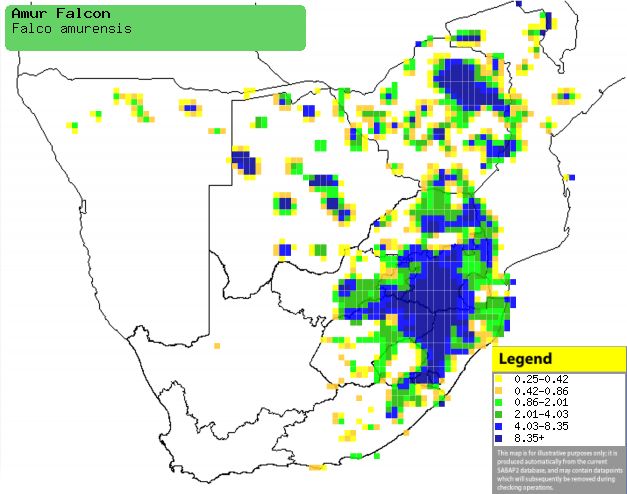|
Falco amurensis (Amur falcon,
Eastern red-footed kestrel)
Oostelike rooipootvalk [Afrikaans]; Seotsanyana (applied
also to kestrel species) [South Sotho]; Rukodzi (generic name for a small raptor
such as falcon or sparrowhawk) [Shona]; Kavakavana, Xikavakava (terms also
applied to Rock kestrel) [Tsonga]; Amoerroodpootvalk [Dutch]; Faucon de l'Amour
[French]; Amur-Rotfußfalke [German]; Falcăo-de-pés-vermelhos-oriental
[Portuguese]
Life
> Eukaryotes >
Opisthokonta
> Metazoa (animals) >
Bilateria >
Deuterostomia > Chordata >
Craniata > Vertebrata (vertebrates) > Gnathostomata (jawed
vertebrates) > Teleostomi (teleost fish) > Osteichthyes (bony fish) > Class:
Sarcopterygii (lobe-finned
fish) > Stegocephalia (terrestrial
vertebrates) > Tetrapoda
(four-legged vertebrates) > Reptiliomorpha > Amniota >
Reptilia (reptiles) >
Romeriida > Diapsida > Archosauromorpha > Archosauria >
Dinosauria
(dinosaurs) > Saurischia > Theropoda (bipedal predatory dinosaurs) >
Coelurosauria > Maniraptora > Aves
(birds) > Order: Falconiformes >
Family: Falconidae
Distribution and habitat
Its breeding grounds stretch across eastern Asia, heading
south in the non-breeding season to south-western Zambia and southern Africa.
Here it is locally common in patches of Zimbabwe, northern Mozambique, Botswana
and the eastern half of South Africa, while scarce in northern Namibia. It
generally prefers open, moist grassland, savanna and croplands,
although it often roosts in trees in city centres.
|
 |
|
Distribution of Amur falcon in southern Africa,
based on statistical smoothing of the records from first SA Bird Atlas
Project (©
Animal Demography unit, University of
Cape Town; smoothing by Birgit Erni and Francesca Little). Colours range
from dark blue (most common) through to yellow (least common).
See here for the latest distribution
from the SABAP2. |
Movements and migrations
Palearctic breeding migrant, undertaking a
roughly 11 000 km long trip, departing from its Asian breeding
grounds from August-September, first arriving in southern Africa in
November (later towards the south of its distribution) and leaving
in the period from April-May.
Food
It almost exclusively eats arthropods, caught either from a
perch or by hovering and repeatedly diving into a large swarm of prey (such as a
termite alate emergence). The following food items have been recorded
in its diet:
Threats
Not threatened.
References
-
Hockey PAR, Dean WRJ and Ryan PG 2005. Roberts
- Birds of southern Africa, VIIth ed. The Trustees of the John Voelcker
Bird Book Fund, Cape Town.
|
